Innovative Device and Procedure for In Situ Quantification of the Self-Healing Ability and Kinetics of Self-Healing of Polymeric Materials
Abstract
1. Introduction
2. Materials and Methods
2.1. Synthesis of the Polyurethanes
- —100% YPD polyurethane—synthesized with the polycarbonate of 1.6 hexanediol polyol with molecular weight of 1000 Da.
- —100% YPD2 polyurethane—synthesized with the polycarbonate of 1.6 hexanediol polyol with molecular weight of 2000 Da.
- —60%YPD40%YPD2 polyurethane—synthesized with a blend of 60 wt.% polycarbonate of 1.6 hexanediol polyol with molecular weight of 1000 Da and 40 wt.% polycarbonate of 1.6 hexanediol polyol with molecular weight of 2000 Da.
- —20%YPD80%YPD2 polyurethane—synthesized with a blend of 20 wt.% polycarbonate of 1.6 hexanediol polyol with molecular weight of 1000 Da and 80 wt.% polycarbonate of 1.6 hexanediol polyol with molecular weight of 2000 Da.
2.2. Device for In Situ Quantification and Monitoring of the Self-Healing of Polymeric Materials
2.3. Procedure for In Situ Measurement of the Self-Healing of Polymeric Materials
3. Results
3.1. Qualitative Assessment of the Self-Healing of Polyurethanes
3.2. Monitoring of the Self-Healing of Polyurethanes by Using the New Device
3.3. Monitoring the Kinetics of Self-Healing and the Self-Healing Time of the Polyurethanes
3.4. Monitoring of the Self-Healing of the Polyurethanes by Using Different Gas Flow Rates
3.5. Monitoring of the Self-Healing of the Polyurethanes by Using Needles of Different Diameters
3.6. Reproducibility of the Self-Healing Assessment of the Polyurethanes
4. Discussion
5. Conclusions
6. Patents
Supplementary Materials
Author Contributions
Funding
Institutional Review Board Statement
Data Availability Statement
Acknowledgments
Conflicts of Interest
References
- Olaitan-Ayeleru, O.; Apata-Olubambi, P. Concept of self-healing in polymeric materials. Mater. Today Proc. 2022, 62, S158–S162. [Google Scholar] [CrossRef]
- Brochu, A.B.W.; Craig, S.L.; Reichert, W.M. Self-healing biomaterials. J. Biomed. Mater. Res. Part A 2011, 96A, 492–506. [Google Scholar] [CrossRef] [PubMed]
- Blaiszik, B.J.; Kramer, S.L.B.; Olugebefola, S.C.; Moore, J.S.; Sottos, N.R.; White, S.R. Self-healing polymers and composites. Annu. Rev. Mater. Res. 2010, 40, 179–211. [Google Scholar] [CrossRef]
- Alaneme, K.K.; Bodunrin, M.O. Self-healing using metallic material systems—A review. Appl. Mater. Today 2017, 6, 9–15. [Google Scholar] [CrossRef]
- Thakur, V.K.; Kessler, M.R. Self-healing polymer nanocomposite materials: A review. Polymer 2015, 69, 369–383. [Google Scholar] [CrossRef]
- Cohades, A.; Branfoot, C.; Rae, S.; Bond, I.; Michaud, V. Progress in self-healing fiber-reinforced polymer composites. Adv. Mater. Interfaces 2018, 5, 1800177. [Google Scholar] [CrossRef]
- Mukherjee, S.; Hill, M.R.; Sumerlin, B.S. Self-healing hydrogels containing reversible oxime crosslinks. Soft Matter 2015, 11, 6152–6161. [Google Scholar] [CrossRef] [PubMed]
- Xu, Z.; Peng, J.; Yan, N.; Yu, H.; Zhang, S.; Liu, K.; Fang, Y. Simple design but marvelous performances: Molecular gels of superior strength and self-healing properties. Soft Matter 2013, 9, 1091–1099. [Google Scholar] [CrossRef]
- Wu, D.Y.; Meure, S.; Solomon, D. Self-healing polymeric materials: A review of recent developments. Prog. Polym. Sci. 2008, 33, 479–522. [Google Scholar] [CrossRef]
- Abend, M.; Tianis, L.; Kunz, C.; Zechel, S.; Gräf, S.; Müller, F.A.; Schubert, U.S.; Hager, M.D. A novel approach for the quantification of scratch healing of polymers. Polym. Test. 2020, 90, 106699. [Google Scholar] [CrossRef]
- Xu, J.; Chen, J.; Zhang, Y.; Liu, T.; Fu, J. A fast room temperature self-healing glassy polyurethane. Angew. Chem. Int. Ed. 2021, 60, 7947–7955. [Google Scholar] [CrossRef] [PubMed]
- Xu, Y.; Chen, D. A novel self-healing polyurethane based on disulfide bonds. Macromol. Chem. Phys. 2016, 217, 1191–1196. [Google Scholar] [CrossRef]
- Jian, X.; Hu, Y.; Zhou, W.; Xiao, L. Self-healing polyurethane based on disulfide bond and hydrogen bond. Polym. Adv. Technol. 2018, 29, 463–469. [Google Scholar] [CrossRef]
- Lefever, G.; Van Hemelrijck, D.; Aggelis, D.G.; Snoeck, D. Evaluation of self-healing in cementitious materials with superabsorbent polymers through ultrasonic mapping. Constr. Build. Mater. 2022, 344, 128272. [Google Scholar] [CrossRef]
- Ying, W.B.; Yu, Z.; Kim, D.H.; Lee, K.J.; Hu, H.; Liu, Y.; Kong, Z.; Wang, K.; Shang, J.; Zhang, R.; et al. Waterproof, highly tough, and fast self-healing polyurethane for durable electronic skin. ACS Appl. Mater. Interfaces 2020, 12, 11072–11083. [Google Scholar] [CrossRef] [PubMed]
- Chang, K.; Jia, H.; Gu, S.-Y. A transparent, highly stretchable, self-healing polyurethane based on disulfide bonds. Eur. Polym. J. 2019, 112, 822–831. [Google Scholar] [CrossRef]
- Kong, D.; Li, J.; Guo, A.; Zhang, X.; Xiao, X. Self-healing high temperature shape memory polymer. Eur. Polym. J. 2019, 120, 109279. [Google Scholar] [CrossRef]
- Ma, J.; Lee, G.-H.; Kim, J.-H.; Kim, S.-W.; Jo, S.; Kim, C.S. A transparent self-healing polyurethane–isophorone-diisocyanate elastomer based on hydrogen-bonding interactions. ACS Appl. Polym. Mater. 2022, 4, 2497–2505. [Google Scholar] [CrossRef]
- Huang, L.; Yi, N.; Wu, Y.; Zhang, Y.; Zhang, Q.; Huang, Y.; Ma, Y.; Chen, Y. Multichannel and repeatable self-healing of mechanical enhanced graphene-thermoplastic polyurethane composites. Adv. Mater. 2013, 25, 2224–2228. [Google Scholar] [CrossRef]
- Lin, M.; Chen, T.; Fu, Q.; Peng, L.; Zhang, S.; Zheng, Z.; Ma, X.; Pan, J. Evaluation Method for Self-Healing Performance of Cable Insulation Material. CN108490130A, 4 September 2018. [Google Scholar]
- Lin, M.; Li, Z.; Tang, N.; Fu, Q.; Peng, L. Method for Evaluating Electrical Performance Recovery Degree of Self-Repairing Material. CN113484651A, 13 April 2016. [Google Scholar]
- Kang, J.; Son, D.; Wang, G.J.N.; Liu, Y.; Lopez, J.; Kim, Y.; Oh, J.Y.; Katsumata, T.; Mun, J.; Lee, Y.; et al. Tough and water insensitive self-healing elastomer for robust electronic skin. Adv. Mater. 2018, 30, 1706846. [Google Scholar] [CrossRef]
- Can a Material Repair Itself? 2022. Available online: https://youtu.be/fmWHSVPYTuU (accessed on 25 March 2023).
- White, S.R.; Sottos, N.R.; Geubelle, P.H.; Moore, J.S.; Kessler, M.R.; Sriram, S.R.; Brown, E.N.; Viswanathan, S. Autonomic healing of polymer composites. Nature 2001, 409, 794–797. [Google Scholar] [CrossRef] [PubMed]
- Brown, E.N.; Sottos, N.R.; White, S.R. Fracture testing of a self-healing polymer composite. Exp. Mech. 2002, 42, 372–379. [Google Scholar] [CrossRef]
- Baker, A.A.; Callinan, R.J. Damage tolerance of graphite/epoxy composites. Compos. Struct. 1985, 4, 15–44. [Google Scholar] [CrossRef]
- Brown, E.; White, S.; Sottos, N. Retardation and repair of fatigue cracks in a microcapsule toughened epoxy composite—Part II: In situ self-healing. Compos. Sci. Technol. 2005, 65, 2474–2480. [Google Scholar] [CrossRef]
- Brown, E.; White, S.; Sottos, N. Retardation and repair of fatigue cracks in a microcapsule toughened epoxy composite—Part I: Manual infiltration. Compos. Sci. Technol. 2005, 65, 2466–2473. [Google Scholar] [CrossRef]
- Jones, A.S.; Rule, J.D.; Moore, J.S.; White, S.R.; Sottos, N.R. Catalyst morphology and dissolution kinetics of self-healing polymers. Chem. Mater. 2006, 18, 1312–1317. [Google Scholar] [CrossRef]
- Lucas, S.S.; von Tapavicza, M.; Schmidt, A.M.; Bertling, J.; Nellesen, A. Study of quantification methods in self-healing ceramics, polymers and concrete: A route towards standardization. J. Intell. Mater. Syst. Struct. 2016, 27, 2577–2598. [Google Scholar] [CrossRef]
- Odriozola, I.; Casuso, P.; Díaz, N.; Loinaz, I.; Cabañero, G.; Grande, H.J. Self-Healing Material and Method for the Preparation Thereof. EP2785765A1, 8 October 2014. [Google Scholar]
- Song, K.; Ye, W.; Gao, X.; Fang, H.; Zhang, Y.; Zhang, Q.; Li, X.; Yang, S.; Wei, H.; Ding, Y. Synergy between dynamic covalent boronic ester and boron–nitrogen coordination: Strategy for self-healing polyurethane elastomers at room temperature with unprecedented mechanical properties. Mater. Horiz. 2021, 8, 216–223. [Google Scholar] [CrossRef]
- Wang, X.; Zhang, H.; Yang, B.; Wang, L.; Sun, H. A colorless, transparent and self-healing polyurethane elastomer modulated by dynamic disulfide and hydrogen bonds. New J. Chem. 2020, 44, 5746–5754. [Google Scholar] [CrossRef]
- Lai, Y.; Kuang, X.; Zhu, P.; Huang, M.; Dong, X.; Wang, D. Colorless, transparent, robust, and fast scratch-self-healing elastomers via a phase-locked dynamic bonds design. Adv. Mater. 2018, 30, 1802556. [Google Scholar] [CrossRef]
- Lin, M.; Chen, T.; Fu, Q.; Peng, L.; Zhang, S.; Zheng, Z.; Pan, J. Method for Evaluating Self-Healing Property of Material. CN108445005A, 4 August 2018. [Google Scholar]
- Lin, M.; Chen, T.; Fu, Q.; Peng, L.; Zhang, S.; Zheng, Z.; Ma, X.; Pan, J. Method for evaluating self-healing property of cable sheath material. CN108680431A, 8 December 2020. [Google Scholar]
- Li, X.; Yu, R.; He, Y.; Zhang, Y.; Yang, X.; Zhao, X.; Huang, W. Self-healing polyurethane elastomers based on a disulfide bond by digital light processing 3D printing. ACS Macro Lett. 2019, 8, 1511–1516. [Google Scholar] [CrossRef] [PubMed]
- Ling, J.; Rong, M.Z.; Zhang, M.Q. Photo-stimulated self-healing polyurethane containing dihydroxyl coumarin derivatives. Polymer 2012, 53, 2691–2698. [Google Scholar] [CrossRef]
- Ji, S.; Cao, W.; Yu, Y.; Xu, H. Visible-light-induced self-healing diselenide-containing polyurethane elastomer. Adv. Mater. 2015, 27, 7740–7745. [Google Scholar] [CrossRef]
- Perepelkin, N.V.; Martin-Martinez, J.M.; Kovalev, A.E.; Borodich, F.M.; Gorb, S.N. Experimental testing of self-healing ability of soft polymer materials. Meccanica 2019, 54, 1959–1970. [Google Scholar] [CrossRef]
- Colera-Llavata, M.; Costa-Vayá, V.; Jofre-Reche, J.A.; Martín-Martínez, J.M. Self-Healing Polyurethane Polymers. EP 3103846 A1, 14 December 2016. [Google Scholar]
- Maes, F.; Montarnal, D.; Cantournet, S.; Tournilhac, F.; Corté, L.; Leibler, L. Activation and deactivation of self-healing in supramolecular rubbers. Soft Matter 2012, 8, 1681–1687. [Google Scholar] [CrossRef]
- Joon, S.K.K.; Hyuk, L.M.; Myong, L.K. Gas Diffusion Test Apparatus and Method for Evaluating Crack Width and Self-Healing Performance of Cracked Specimen. KR102105840, 9 April 2020. [Google Scholar]
- Liang, F.C.; Jhuang, F.C.; Fang, Y.H.; Benas, J.S.; Chen, W.C.; Yan, Z.L.; Lin, W.C.; Su, C.J.; Sato, Y.; Chiba, T.; et al. Synergistic effect of cation composition engineering of hybrid Cs1−xFAxPbBr3 nanocrystals for self-healing electronics application. Adv. Mater. 2023, 35, 2207617. [Google Scholar] [CrossRef] [PubMed]
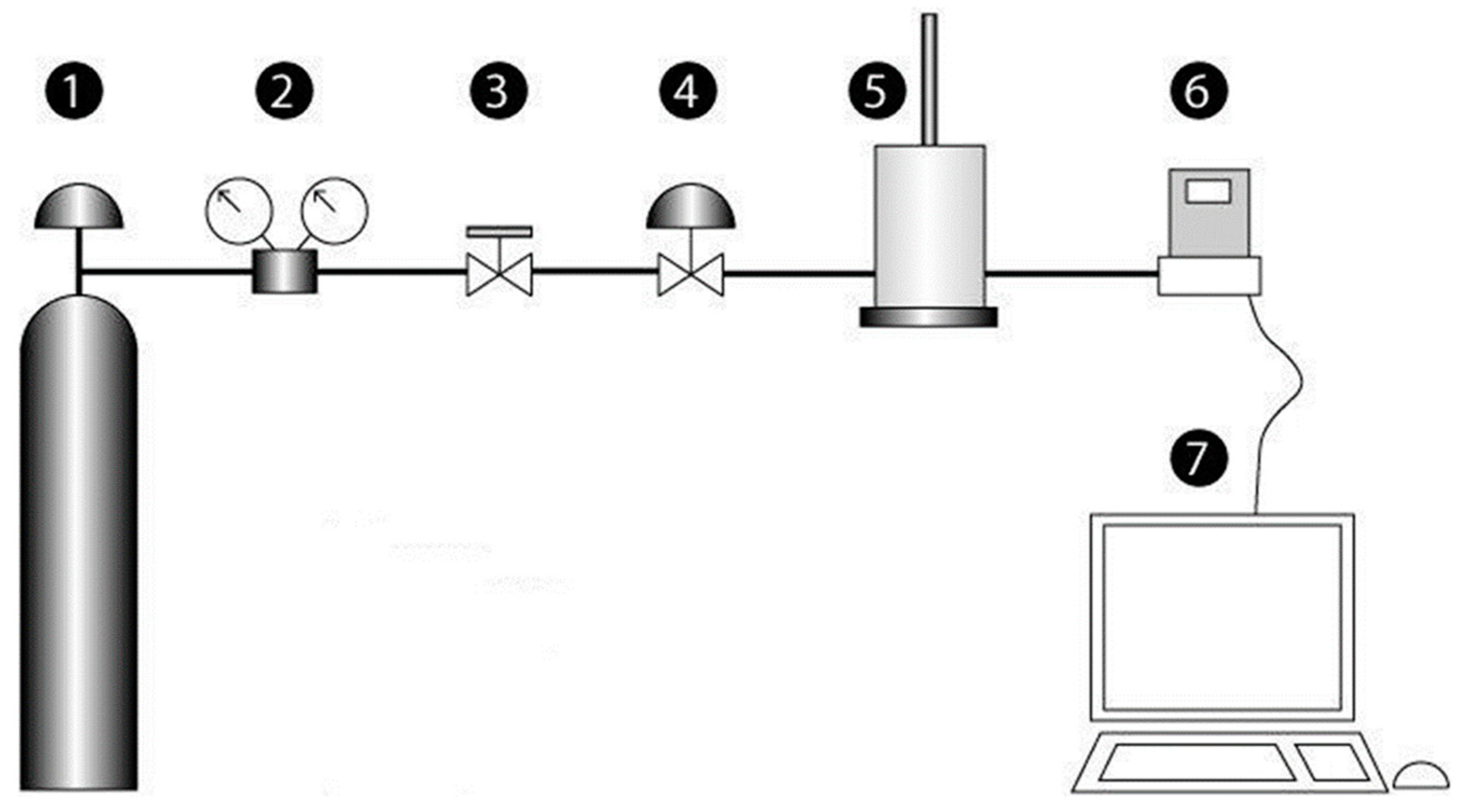
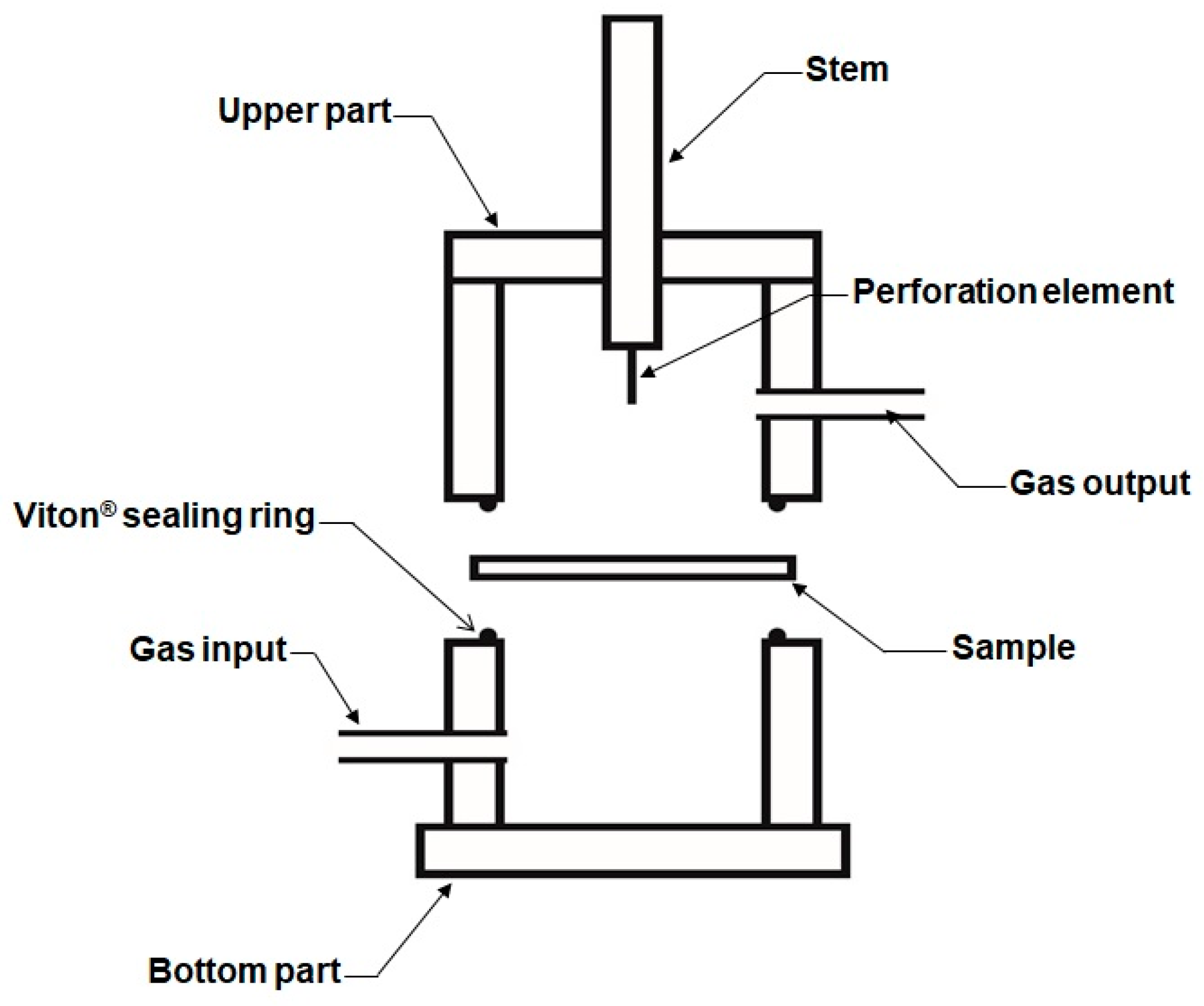


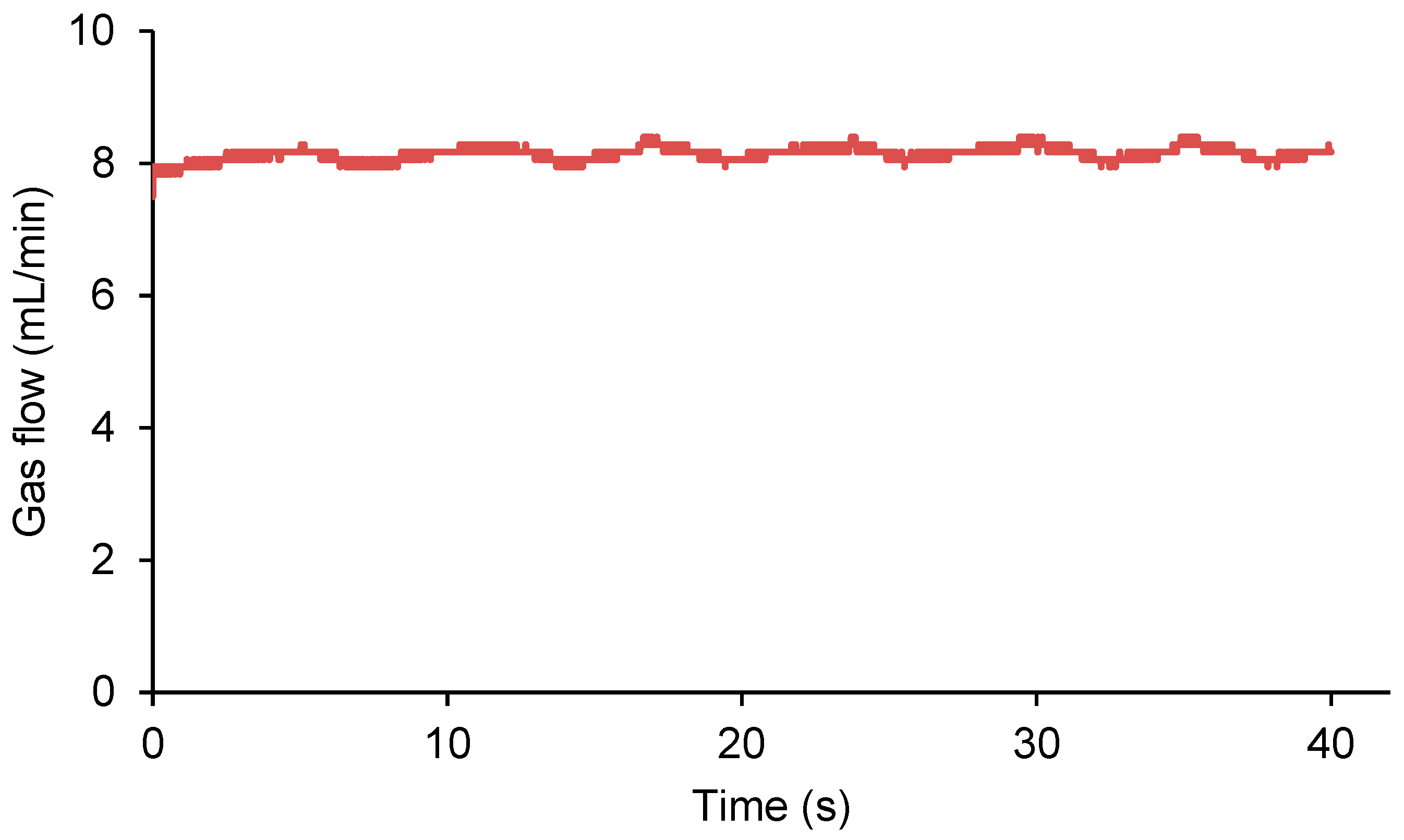

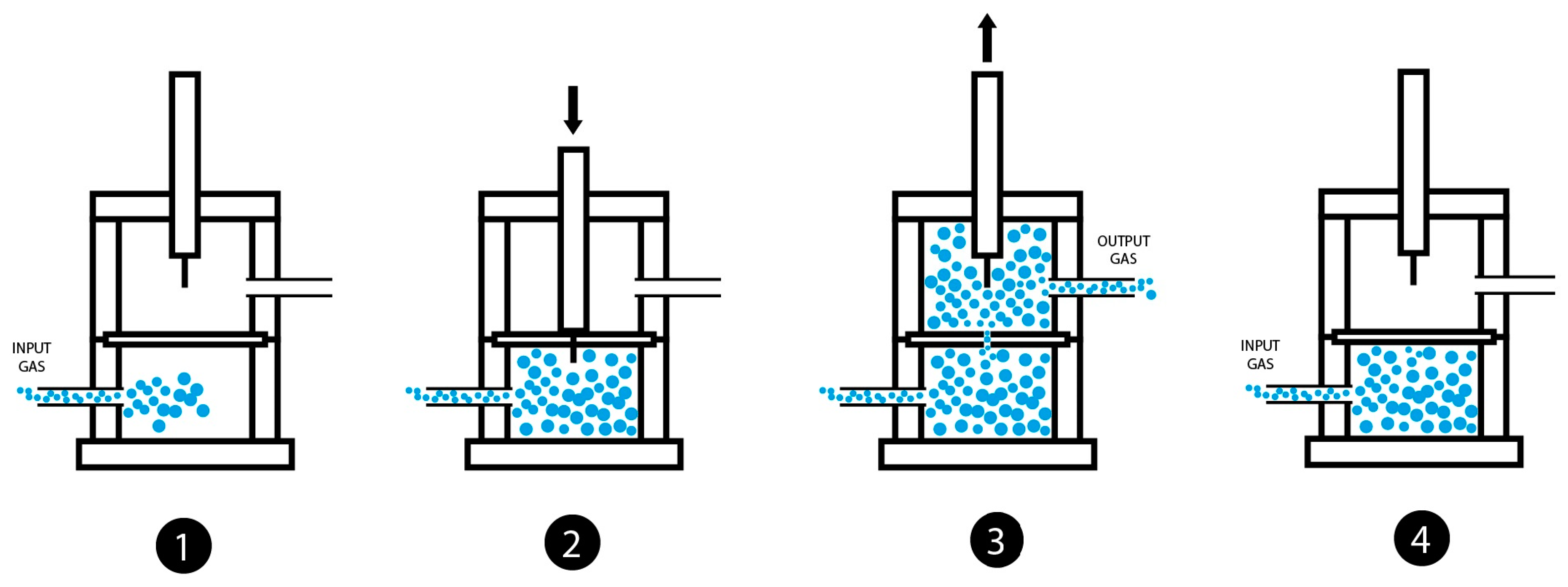
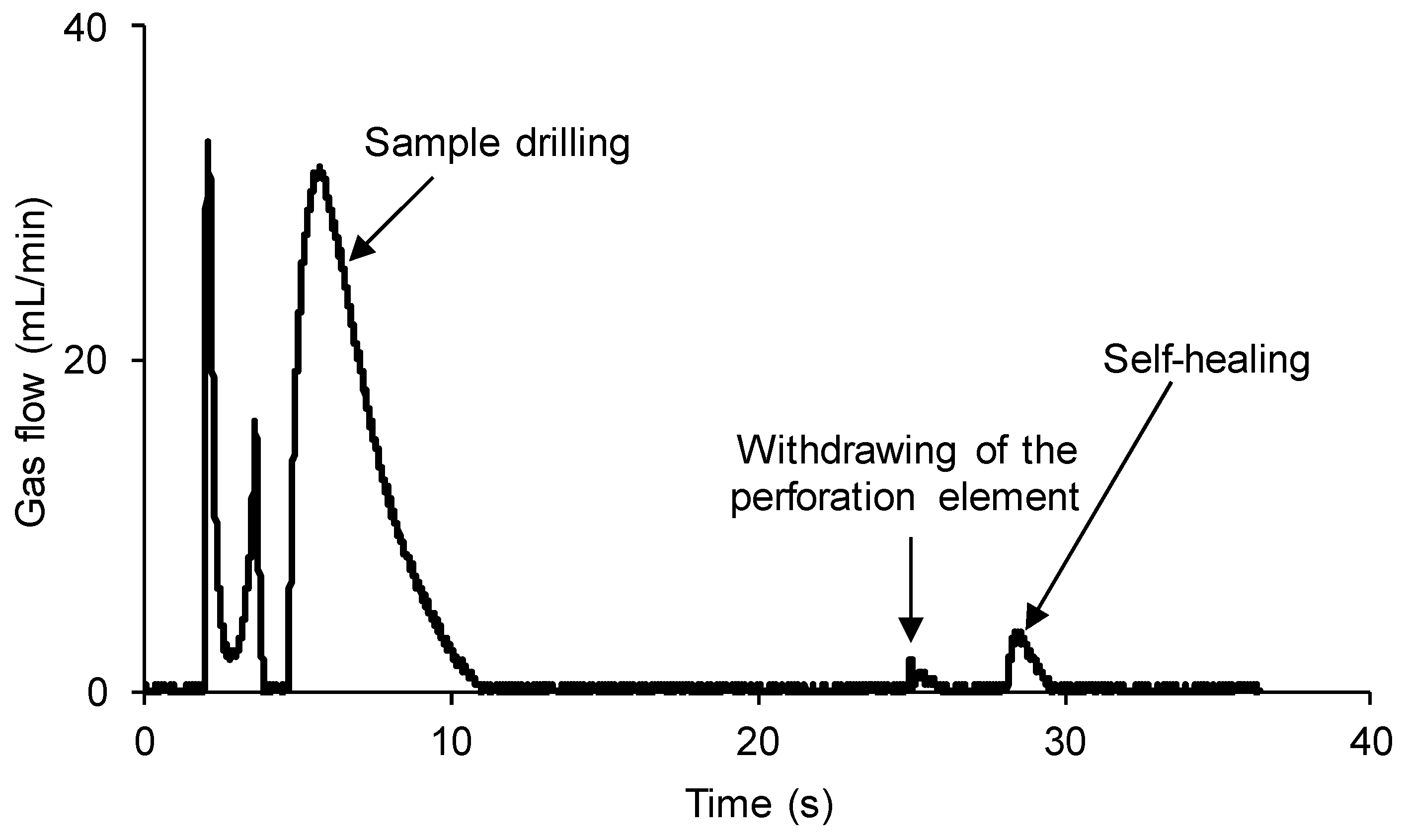


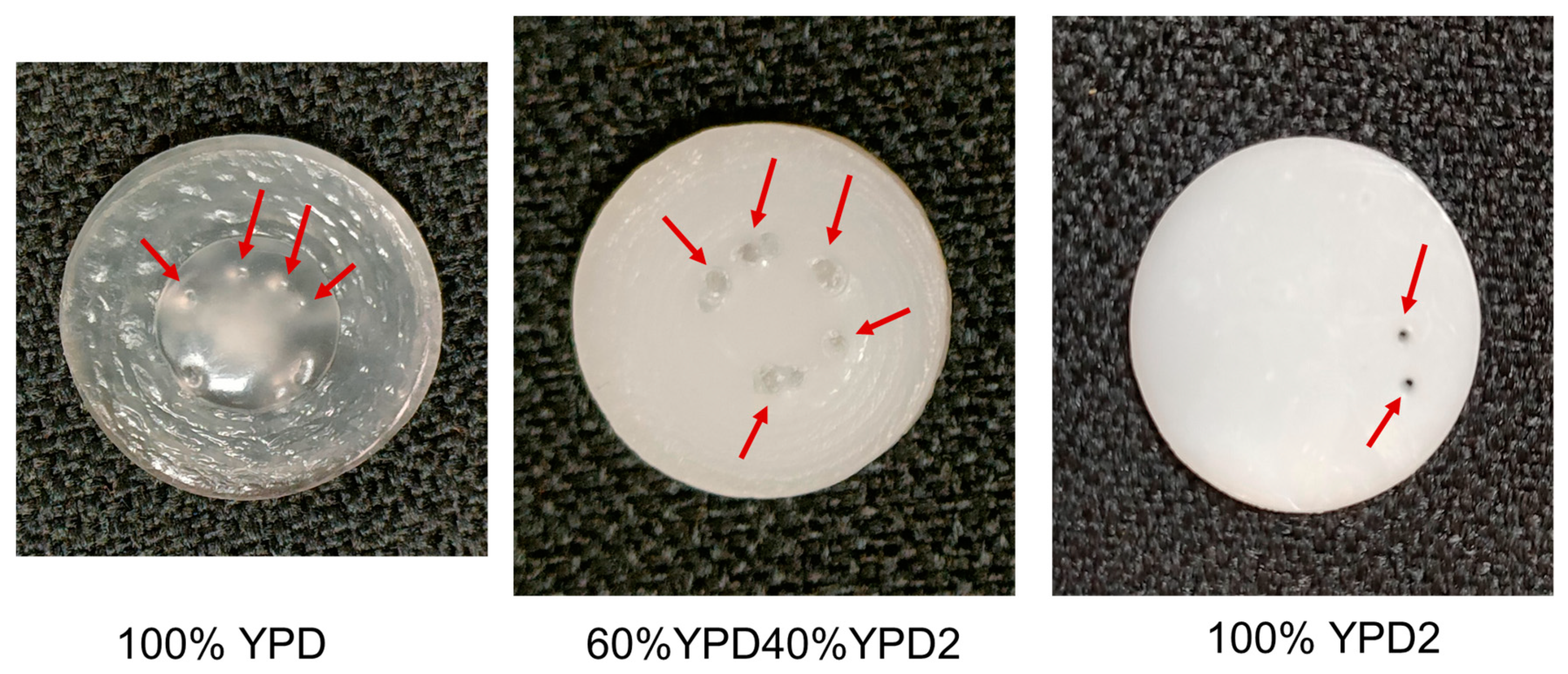
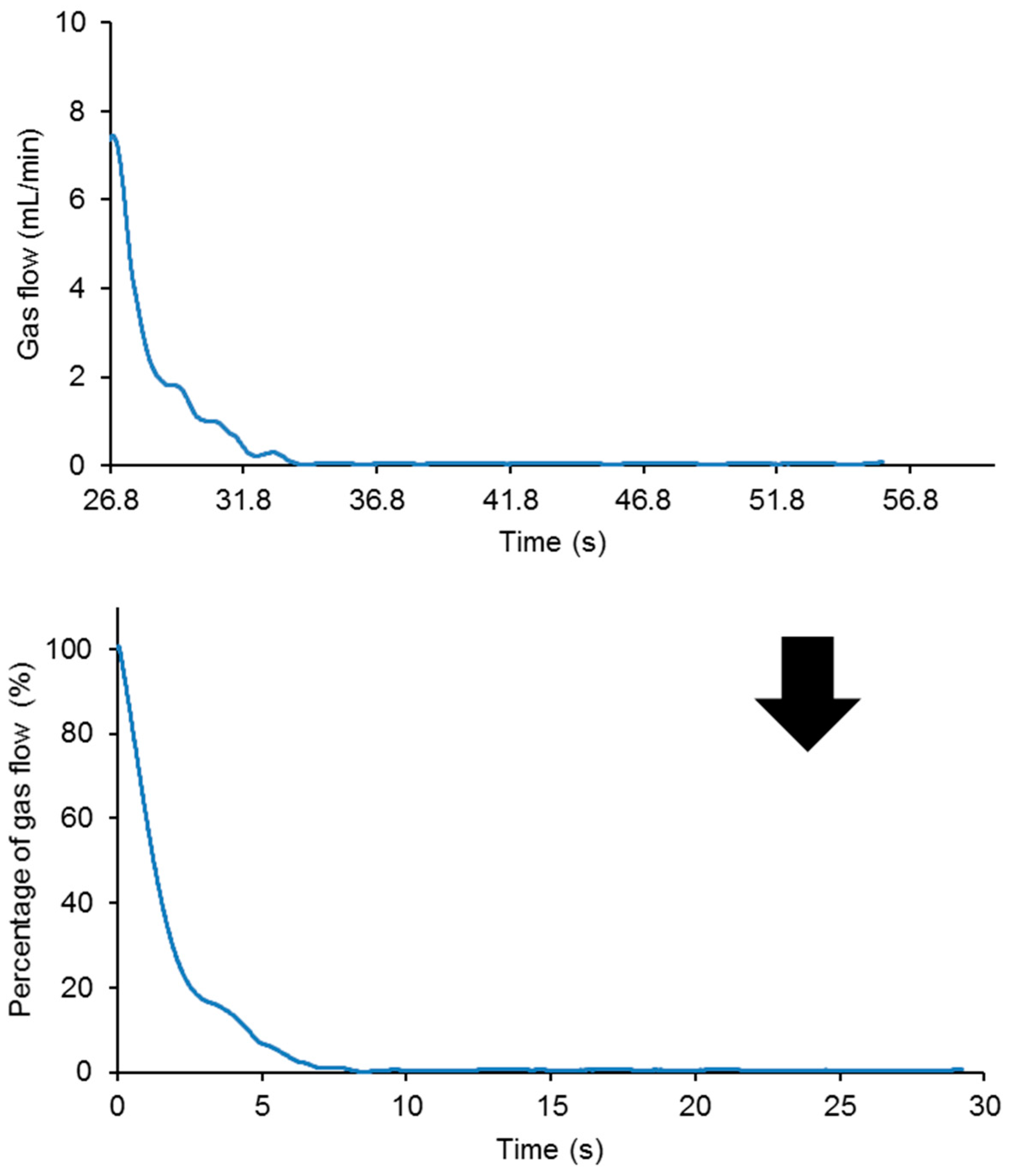
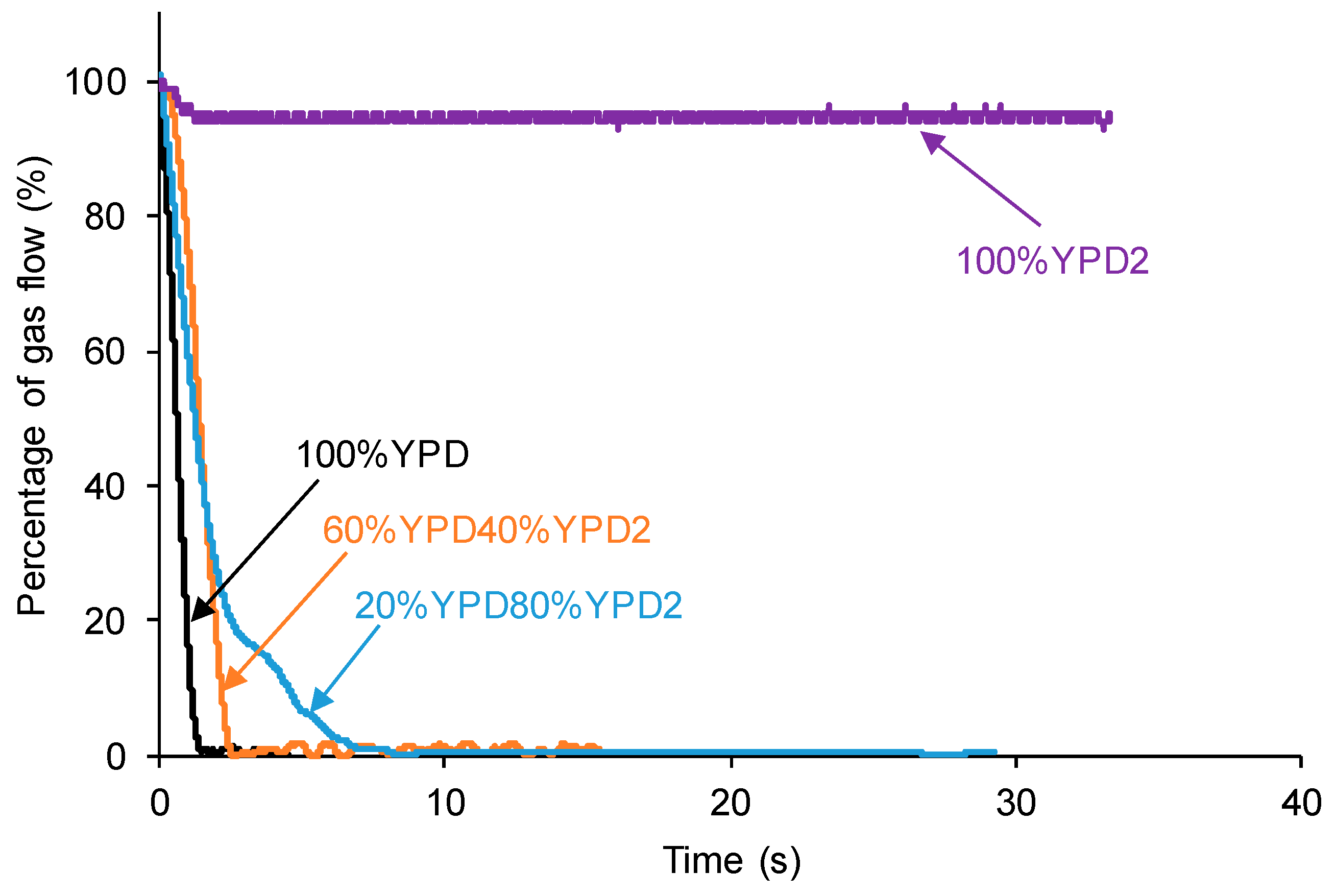
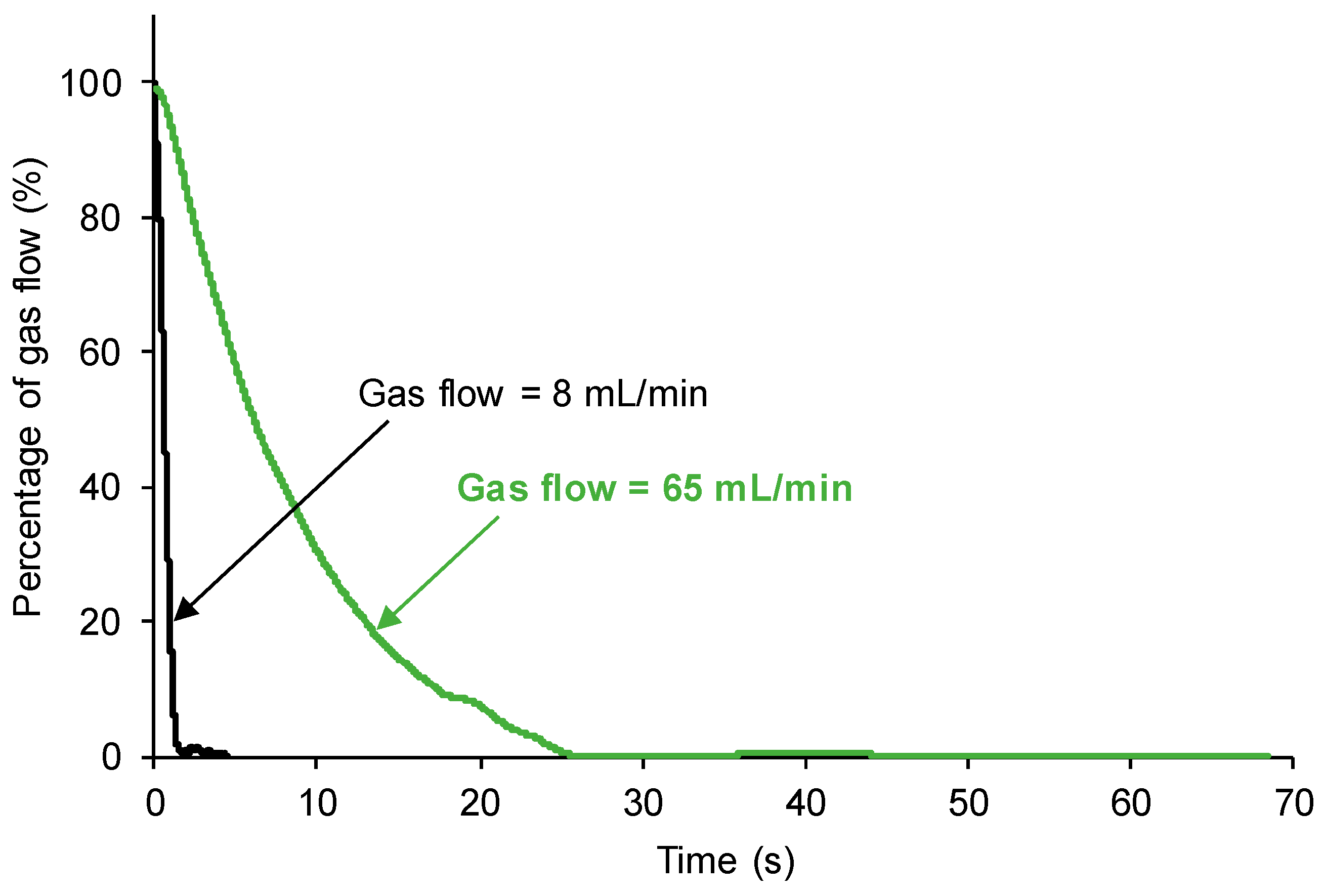


| PU | Self-Healing Time (s) |
|---|---|
| 100%YPD | 1.4 |
| 60%YPD40%YPD2 | 2.5 |
| 20%YPD80%YPD2 | 8.5 |
| 100%YPD2 | No self-healing |
| Gas Flow Rate (mL/min) | Self-Healing Time (s) |
|---|---|
| 8 | 1.4 |
| 65 | 26 |
| Needle Diameter (mm) | Self-Healing Time (s) |
|---|---|
| 0.5 | 0.4 |
| 1 1.5 | 2.5 8.6 |
| Drilling | Self-Healing Time (s) |
|---|---|
| 1 | 26 |
| 2 | 25 |
| 3 | 24 |
| Average | 25 ± 1 |
Disclaimer/Publisher’s Note: The statements, opinions and data contained in all publications are solely those of the individual author(s) and contributor(s) and not of MDPI and/or the editor(s). MDPI and/or the editor(s) disclaim responsibility for any injury to people or property resulting from any ideas, methods, instructions or products referred to in the content. |
© 2023 by the authors. Licensee MDPI, Basel, Switzerland. This article is an open access article distributed under the terms and conditions of the Creative Commons Attribution (CC BY) license (https://creativecommons.org/licenses/by/4.0/).
Share and Cite
Paez-Amieva, Y.; Carpena-Montesinos, J.; Martín-Martínez, J.M. Innovative Device and Procedure for In Situ Quantification of the Self-Healing Ability and Kinetics of Self-Healing of Polymeric Materials. Polymers 2023, 15, 2152. https://doi.org/10.3390/polym15092152
Paez-Amieva Y, Carpena-Montesinos J, Martín-Martínez JM. Innovative Device and Procedure for In Situ Quantification of the Self-Healing Ability and Kinetics of Self-Healing of Polymeric Materials. Polymers. 2023; 15(9):2152. https://doi.org/10.3390/polym15092152
Chicago/Turabian StylePaez-Amieva, Yuliet, Jaime Carpena-Montesinos, and José Miguel Martín-Martínez. 2023. "Innovative Device and Procedure for In Situ Quantification of the Self-Healing Ability and Kinetics of Self-Healing of Polymeric Materials" Polymers 15, no. 9: 2152. https://doi.org/10.3390/polym15092152
APA StylePaez-Amieva, Y., Carpena-Montesinos, J., & Martín-Martínez, J. M. (2023). Innovative Device and Procedure for In Situ Quantification of the Self-Healing Ability and Kinetics of Self-Healing of Polymeric Materials. Polymers, 15(9), 2152. https://doi.org/10.3390/polym15092152








